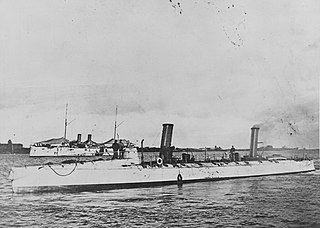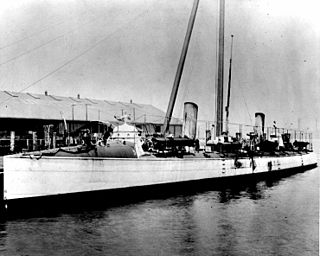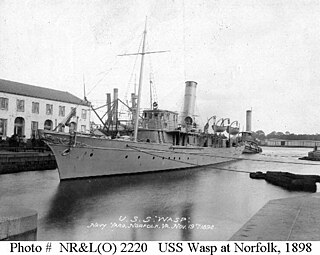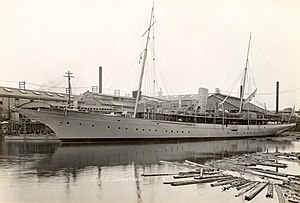
USS New Orleans was a United States Navy protected cruiser of the New Orleans class.

USS Badger was an auxiliary cruiser of the United States Navy, the first U.S. Navy ship named after the burrowing mammal.

The first USS Panther (AD-6), the former SS Venezuela, was an auxiliary cruiser and naval troop transport in the United States Navy.

The first USS Minneapolis (C-13/CA-17) was a United States Navy Columbia-class protected cruiser. She was named for the city of Minneapolis, Minnesota.
The fifth USS Eagle served in the United States Navy from 1898–1919, and saw action in the Spanish–American War and service during World War I.

The second USS Marblehead (C-11/PG-27) was a Montgomery-class unprotected cruiser in the United States Navy, authorized in the naval appropriations bill of September 7, 1888. Marblehead served in the Spanish–American War and World War I, and was the last ship of her class in service.

USS K-5 (SS-36) was a K-class submarine of the United States Navy. Her keel was laid down by the Fore River Shipbuilding Company in Quincy, Massachusetts, under a subcontract from the Electric Boat Company of Groton, Connecticut. She was launched on 17 March 1914 sponsored by Mrs. Warren G. Child, and commissioned on 22 August with Lieutenant H. Gibson in command.

USS Mayflower (PY-1) was the second ship in the United States Navy to have that name. Mayflower was a luxurious steam yacht built in 1896, by J. and G. Thompson, Clydebank, Scotland for millionaire Ogden Goelet, who died on board Mayflower, in August 1897. Her sister ship, said to be almost identical and built at the same time and in the same yard for brother, Robert Goelet, later became USS Nahma.

The second USS Amphitrite—the lead ship in her class of iron-hulled, twin-screw monitors—was laid down, on June 23, 1874 by order of President Ulysses S. Grant's Secretary of Navy George M. Robeson at Wilmington, Delaware, by the Harlan and Hollingsworth yard; launched on 7 June 1883; sponsored by Miss Nellie Benson, the daughter of a Harlan and Hollingsworth official; and commissioned at the Norfolk Navy Yard, Portsmouth, Virginia, on 23 April 1895, Captain William C. Wise in command.

USS Cincinnati (C-7) was a protected cruiser and the lead ship of the Cincinnati-class cruiser for the United States Navy. She was launched on 10 November 1892 by New York Navy Yard; sponsored by Miss S. Mosby; and commissioned on 16 June 1894, Captain Henry Glass in command. She was the second ship to be named after Cincinnati, Ohio.

USS Vicksburg was a United States Navy gunboat, laid down in March 1896 at Bath, Maine, launched on 5 December 1896, and commissioned on 23 October 1897.

The first USS Machias (PG-5), a schooner-rigged gunboat, was laid down in February 1891 by Bath Iron Works, Bath, Maine. She was launched on 8 December 1891. She was sponsored by Miss Ethel Hyde, daughter of President Hyde of Bath Iron Works and commissioned at Portsmouth Navy Yard, Kittery, Maine, 20 July 1893, Commander Charles J. Train in command.

The first USS Ericsson was the second torpedo boat built for the United States Navy. The first,Cushing, had been built seven years earlier.

USS Foote was launched 1 October 1896 by Columbian Iron Works and Dry Dock Co., Baltimore, Md.; sponsored by Miss Laura Price; and commissioned 7 August 1897, Lieutenant W. L. Rodgers in command.

USS Marietta was a schooner-rigged gunboat. She was laid down by Union Iron Works, San Francisco, California, on 13 April 1896 and launched on 18 March 1897, sponsored by Mrs. C. L. More, daughter of Brigadier General T. C. H. Smith and commissioned in September 1897, with Commander F. W. Symonds in command.

USS Topeka (PG-35) was a gunboat of the United States Navy.

USS De Soto was a fast wooden-hulled sidewheel steamship that saw service as a U.S. Navy gunboat during the American Civil War.

The seventh USS Wasp was the former yacht Columbia, purchased by the U.S. Navy and converted to an armed yacht serving from 1898 to 1919, with service in the Spanish–American War and World War I.

The sixth USS Niagara (SP-136), later PY-9, was a United States Navy patrol vessel in commission from 1918 to 1931 and which served during World War I.

The fourth USS Scorpion was a steam yacht in commission in the United States Navy from 1898 to 1899, 1899 to 1901, and 1902 to 1927.



















